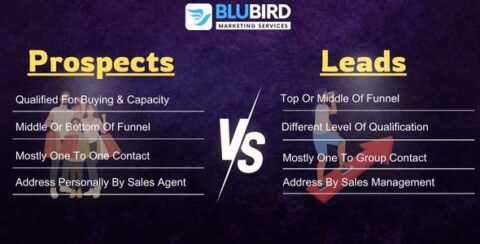Every client or consumer is first a complete stranger. You can only take a stranger and have them go through the funnel from lead to prospect to that sacred spot known as conversion land if you use a consistent sales procedure. Lead and prospect are just two of the many terms used to characterize the state of a business relationship. A lead is a prospective client who meets your target market but is not quite ready to buy. You have personally selected (by hand, or by automation) a group of potential customers based on your study. The lead has become a prospect if they respond well to your offer.
They will still be a lead though if they do not reply or if they are not ready to buy. These leads are frequently referred to as “cold leads” if they consistently reject your attempts to contact them. In this blog post we will discuss Lead vs Prospect in marketing and how to convert them to opportunities.
What Is Leads In Marketing?
Lead refers to any person who is potentially a potential customer of your business. Because of its broad meaning, leads are positioned at the top of the sales funnel. There are numerous approaches to lead generation. You can look via LinkedIn for instance to locate individuals who might be considering your products. Alternatively offer free high quality content in return for email addresses to be added to lists or post advertisements on social media. or welcome recommendations from clients or make a chilly call.
The problem with leads is that they are usually not qualified. That does not imply that you should approach every stranger you meet. A lead is someone who could purchase from you as was previously stated. However likely a large percentage of your leads will not match the profile of your perfect client. They would be prospects if they did.
Where Do Leads Come From?
Let us say you run a modest company that offers custom jewelry for sale. Being active in local craft fairs, running ads on well known fashion and beauty websites or landing a slot on a morning talk show about up and coming jewelry designers might all lead to lead generation. No matter how you choose to create leads, you should always think about expanding your audience and stimulating their interest in your offer.
What Is A Prospect In Marketing?
Prospects are leads that have either interacted with you and indicated they would be strong candidates for outreach, or who have been identified by your sales staff as fitting the profile of your ideal client.
In the sales funnel the second stage is to qualify leads as prospects and determine which prospects are worth contacting. The biggest dropoff in the sales funnel typically occurs when a lead becomes a prospect. This is because qualifying takes into account some variables, the most significant of which is the likelihood that a lead will ultimately become a client. A prospect is deemed “qualified” as they have demonstrated interest in doing business with you and as such, they are deemed likely to become new customers.
Can A Prospect Also Be Referred To As A Lead?
A prospect is a potential client who has moved farther down the sales funnel suggesting that a sale could take place. Another name for them is sales ready leads. A prospect is someone who satisfies all requirements to be considered as a potential customer whereas a lead is someone who has provided the company with their basic contact information and may be within their target market. To put it another way a prospect is a lead that meets your desired consumer profile and has been identified as a strong fit for your product or service.
Lead Versus Prospect: Why Does It Matter?
Leads and prospects are two distinct groups of people in your sales and marketing and they need two different kinds of communication. The main goal of lead communication is to raise interest in and awareness of your offering. Building relationships with prospects through communication is the key to advancing that relationship through the sales funnel.
Now let us discuss communication. Leads are people with whom you have had one sided conversations. They are as follows;
- Those unfamiliar with your email list
- You have messaged new connections on LinkedIn.
- Those who leave comments on blogs
- Individuals who have shared or liked your social media posts
- Names on a list that you bought from a marketing company
Although they have not yet spoken with you or your sales staff leads have the potential to become clients. One-sided communication is prevalent.
On the other hand, Prospects have expressed interest and are engaged. A prospect might be for example;
- An individual you have had phone conversations with
- A reply to one of your emails from someone
- A potential customer who visited your website after clicking on a link in an email
- Someone at a trade fair you spoke with who is in your target market
- An individual who has inquired about your offering in a social media conversation
Prospects are located a little lower down the sales funnel than leads.
How To Convert Leads Into Customers
Converting leads into paying customers is the ultimate goal of any business. However turning prospects into clients may be a difficult undertaking, and many businesses find it difficult to achieve this. We will go over some pointers and techniques for successfully converting leads into customers.
Build Trust With Customers
If you want to guarantee that every customer returns to your business and refers you to their friends, family and colleagues, you should handle every customer in the exact opposite way as the Wolf of Wall Street. You will be up against it and your business will not be able to draw in and keep clients without this trust. In the connected world of 2020 this strategy will not hold up if you are known for being the only player in a given market that exists to take customers money and disregard feedback.
On the other hand if you are working to enhance your offerings for your clients, they will respect your company and value decisions that serve their needs. Recall that consumers cast their votes with their money and they frequently refrain from doing so in front of dishonest people or establishments.
Value For Customers
After you have established a solid foundation of trust with your clients, it is time to deliver some real value. Surprisingly, when it came to competence and the capacity to improve the lives of common people, enterprises scored higher than the government, NGOs, and the media.
When it came to creating value fostering innovation and promoting economic success, business came in first. In a similar streak companies continue to be among the best means of providing significant change and value to their clientele and they continue to be among the most efficient means of adding value to their lives. You can practically guarantee that if you can improve your clients’ lives, they will improve the value of your business.
Honesty In Customer Service
Assuring that your company maintains its position as one of the industry’s top offers in terms of reliability, ethics and mission will motivate both your staff and your clients. Customers will trust your company more and think that you are making important decisions based on their input if you make the extra effort to get in touch with them and ask how your business could improve its services, specifically for them. This is crucial for building customer trust and turning leads into paying customers because reviews from satisfied clients provide social proof to support your claims of honesty, reliability and value adding services.
Conclusion
In the blog above we have examined the Lead vs Prospect and How To Convert Them into Opportunities. For any sales or marketing professional trying to gain an advantage over their competitors, knowing the difference between leads and prospects is essential. Those who have a higher propensity to convert after being guided through your sales process are considered prospects. Leads, on the other hand are possible clients who have recently expressed interest in what you have to offer.






